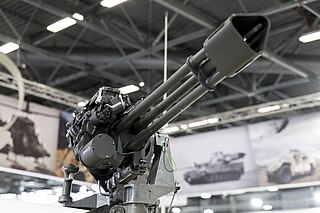
The M61 Vulcan is a hydraulically, electrically, or pneumatically driven, six-barrel, air-cooled, electrically fired Gatling-style rotary cannon which fires 20 mm × 102 mm rounds at an extremely high rate. The M61 and its derivatives have been the principal cannon armament of United States military fixed-wing aircraft for over sixty years.

Anti-aircraft warfare is the counter to aerial warfare and it includes "all measures designed to nullify or reduce the effectiveness of hostile air action". It includes surface based, subsurface, and air-based weapon systems, associated sensor systems, command and control arrangements, and passive measures. It may be used to protect naval, ground, and air forces in any location. However, for most countries, the main effort has tended to be homeland defence. Missile defence is an extension of air defence, as are initiatives to adapt air defence to the task of intercepting any projectile in flight.

An autocannon, automatic cannon or machine cannon is a fully automatic gun that is capable of rapid-firing large-caliber armour-piercing, explosive or incendiary shells, as opposed to the smaller-caliber kinetic projectiles (bullets) fired by a machine gun. Autocannons have a longer effective range and greater terminal performance than machine guns, due to the use of larger/heavier munitions, but are usually smaller than tank guns, howitzers, field guns, or other artillery. When used on its own, the word "autocannon" typically indicates a non-rotary weapon with a single barrel. When multiple rotating barrels are involved, such a weapon is referred to as a "rotary autocannon" or occasionally "rotary cannon", for short.

A gunship is a military aircraft armed with heavy aircraft guns, primarily intended for attacking ground targets either as airstrike or as close air support.

The EurocopterAS565 Panther is the military version of the Eurocopter AS365 Dauphin medium-weight multi-purpose twin-engine helicopter. The Panther is used for a wide range of military roles, including combat assault, fire support, anti-submarine warfare, anti-surface warfare, search and rescue, and medical evacuation.

Strafing is the military practice of attacking ground targets from low-flying aircraft using aircraft-mounted automatic weapons. Less commonly, the term is used by extension to describe high-speed firing runs by any land or naval craft such as fast boats, using smaller-caliber weapons and targeting stationary or slowly-moving targets.
KNDS France was a French government-owned weapons manufacturer, based in Versailles. In 2015, Nexter and Krauss-Maffei Wegman merged under a single structure to form KNDS.

The M197 electric cannon is a 20 mm three-barreled electric Gatling-type rotary cannon used by the United States military.

The General Dynamics GAU-12/U Equalizer is a five-barrel 25 mm Gatling-type rotary cannon. The GAU-12/U is used by the United States, Italy and Spain, which mount the weapon in their attack jets such as the AV-8B Harrier II, airborne gunships such as the Lockheed AC-130, and land-based fighting vehicles. A lighter four-barrel version, designated GAU-22/A, is mounted on F-35 Lightning II fighter jets.
The M134 Minigun is an American 7.62×51mm NATO six-barrel rotary machine gun with a high rate of fire. It features a Gatling-style rotating barrel assembly with an external power source, normally an electric motor. The "Mini" in the name is in comparison to larger-caliber designs that use a rotary barrel design, such as General Electric's earlier 20 mm M61 Vulcan, and "gun" for the use of rifle ammunition as opposed to autocannon shells.

The M39 cannon is a 20 mm caliber single-barreled revolver cannon developed for the United States Air Force in the late 1940s. It was used on a number of fighter aircraft from the early 1950s through the 1980s.

The General Electric GAU-13/A is a 30 mm electric Gatling-type rotary cannon derived from the GAU-8 Avenger cannon.

The GIAT 30 is a series of 30 mm cannon developed to replace the DEFA 550 series weapons on French military aircraft.

A gun pod is a detachable pod or pack containing machine guns, autocannons, revolver cannons, or rotary cannons and ancillaries, mounted externally on a vehicle such as a military aircraft which may or may not also have its own guns.

The M242 Bushmaster chain gun is a 25 mm (25×137mm) single-barrel chain-driven autocannon. It is used extensively by the U.S. military, such as in the Bradley fighting vehicle, as well as by other NATO members and some other nations in ground combat vehicles and various watercraft. Hughes Helicopters in Culver City, California, was the original designer and manufacturer. As of 2019, Northrop Grumman Innovation Systems produces the gun.

The XM214 Microgun is an American prototype 5.56 mm rotary-barreled machine gun. It was designed and built by General Electric. The XM214 was a scaled-down smaller and lighter version of the M134 Minigun, firing M193 5.56×45mm ammunition.

The United States military has developed a number of Helicopter Armament Subsystems since the early 1960s. These systems are used for offensive and defensive purposes and make use of a wide variety of weapon types including, but not limited to machine guns, grenade launchers, autocannon, and rockets. Various systems are still in use, though many have become obsolete.

The EurocopterAS550 Fennec and AS555 Fennec 2 are lightweight, multipurpose military helicopters manufactured by Eurocopter Group. Based on the AS350 Ecureuil and AS355 Ecureuil 2 series, they are named after the fennec fox. The armed versions of the AS550 and AS555 can be fitted with coaxial weapons, rockets, torpedoes and various other munitions.

The GAU-19/A is an electrically driven, three-barrel rotary heavy machine gun that fires the .50 BMG cartridge.

The Nexter Narwhal is a type of remotely operated naval artillery turret made by the French company Nexter. It houses a 20 mm autocannon based on the Nexter M621 and M693. The name "Narwhal" is a backronym of "NAval Remote Weapon, Highly Accurate, Lightweight". It is designed to fit warships of all types ranging from patrol boats to frigates to aircraft carriers, notably as a close-quarters self-defence weapon.


















